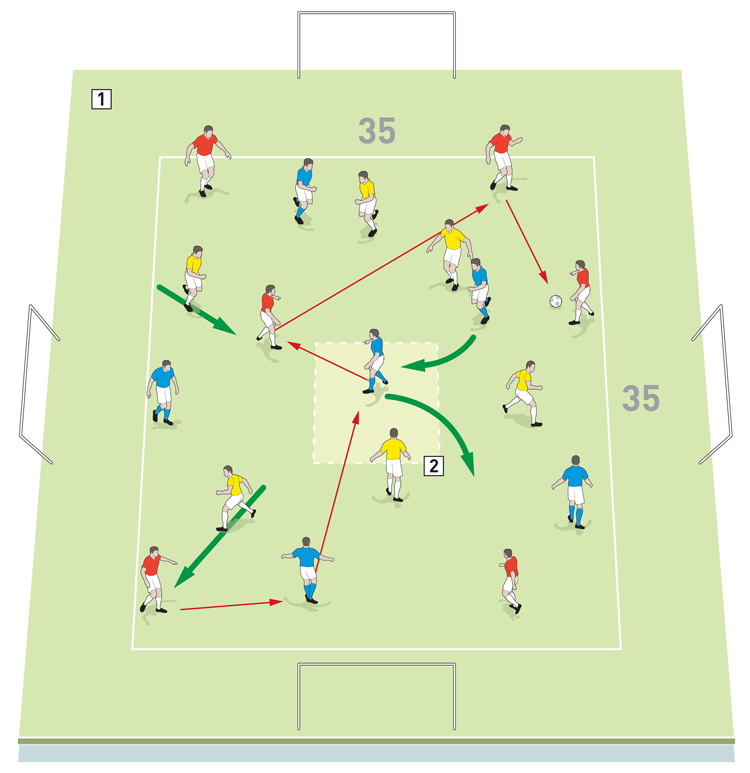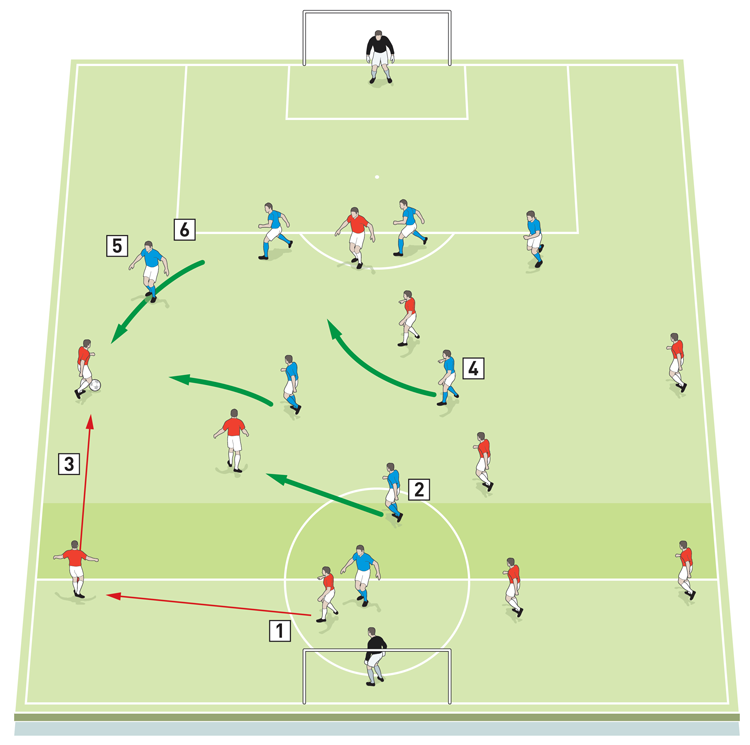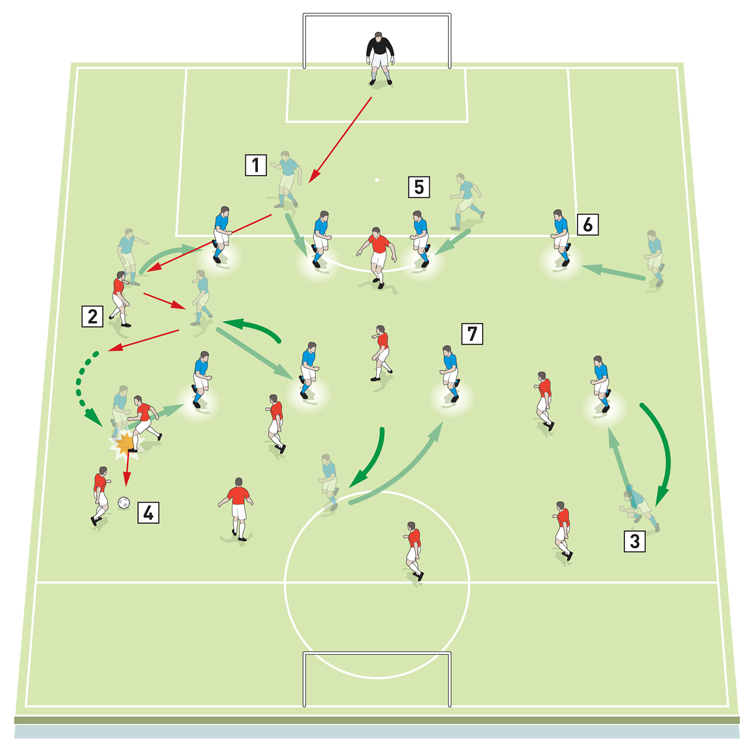Defensive principles
This is all about setting out a defensive mainframe that also focused on the important aspect of transitions because, as a team, you want to attack and score goals, yet you know that by doing so you will lose possession. So that is when the defensive strategies come into play even more.

| Area | Use of a full pitch |
| Equipment | Balls, cones, goals, mini-goals |
| No. of Players | Up to 11v9 |
| Session Time | Warm-up 10mins, Pressing exercise 18mins, Defensive shape 20mins, Small-sided game 20mins |
In such a competitive league as the Sky Bet Championship, where there are no easy games, we knew nailing defensive principles was going to be imperative.
With that in mind we were able to have a very good pre-season where players took on board these elements, with the idea of setting out a defensive mainframe that also focused on the important aspect of transitions because, as a team, you want to attack and score goals, yet you know that by doing so you will lose possession. So that is when the defensive strategies come into play even more.
We have run this session in the lead-up to some matches and it is one players enjoy because of its high tempo and competitiveness.
What do I get the players to do?
Warm up (not shown)
The fitness coach begins with a warm-up. This must be high tempo given the nature of the work the players are leading into.
Pressing exercise
We set this up in a 35x35-yard area with four mini-goals on the outside, as shown (1). It’s a possession session - 12v6 ‘keep ball’ (say, blues and reds combined versus yellows) with players operating two-touch. The team of 12 must retain the ball for as long as possible.
When yellows turn over the ball they play ‘all-in’ with the aim of scoring in any of the four mini-goals. The team of 12 must react as soon as they lose the ball, pressing hard to win it back.
When the ball is played through the middle zone, there has to be a rotation of personnel - the reason for this is so we don’t get players standing on the outsides protecting the four goals.
1

2. If the ball is played into the central zone the players must rotate, with the passing player leaving and a new player taking his place
We play six mini-games of 90secs (with 30secs recovery), rotating teams every time, progressing on to three final games that are played one-touch.
Defensive shape
Now we set up across the full width of the pitch using a half-pitch extended by 15 yards, as shown (2). The aim here is to test shape and compactness, with defensive players looking to deny balls into the front men.
There is a 10v8 overload with the only restriction being that full-backs have two touches. The reason for this is we know we are overloading the defensive set-up, and although the blue central midfielders will have to adjust their shape we don’t want them continually having to defend in the wide areas. And the use of a no.10 and a no.9 is to ensure that when the defending team regains possession they have options to play forward and score.
2

2. The no.10 tracks the path of the ball
3. Now the attacking move progresses up the left flank
4. Blue midfielders shift across to support and track play
5. The right full-back approaches so as to delay play
6. When the red progresses high enough the blue full-back engages in order to negate space
Normal game rules apply (except no corners) and we will frequently stop play in order to make coaching points. In particular we want to note how players cope with overloads in wide areas with midfielders getting dragged out, as well as assessing defending from crosses and opportunities to press. We also want to draw reference to the zone for the no.10 to work in, and the role of the defending deep-lying midfielders.
Small-sided game
In the same area we now set up a game situation. Again it’s normal rules (no corners) with the overloading team (reds) on three-touch and the defending team (two banks of four) all-in. In the defensive banks we are looking for compactness, pressing and coping with overloads on transition. We will encourage blues to attack with numbers - looking for wide players to offer more offensive options as the team tries to score; then the reds attack.
What are the key things to look out for?
It’s all about the transitions - when the two banks of four are attacking, one or two will have to come out of the shape. So if the ball is on the right-hand side, your left winger should try to get in an advanced position.
And while there will be opportunities to attack, in transition players will quickly have to get into a defensive mode and shape (3).
3 Transition to a defensive shape

2. The midfield player drops to support and the ball is played out to the wing
3. As the blues advance down the right, the opposite winger is encouraged to move forwards
4. Reds close down the winger and the ball is won back
Immediately the ball is lost the blue team must recover to their defensive shape – two backs of four
5. Centre-backs ‘push up’ to deny space
6. Full-backs move in-field to make a concentrated defensive shape
7. Midfield players must work hard to return to their defensive positions
Editor's Picks
Attacking transitions
Deep runs in the final third
Using the goalkeeper in build-up play
Intensive boxes drill with goals
Penetrating the final third
Creating and finishing
My philosophy
Pressing initiation
Compact team movement
Coaches' Testimonials

Alan Pardew

Arsène Wenger

Brendan Rodgers

Carlos Carvalhal

José Mourinho

Jürgen Klopp

Pep Guardiola

Roy Hodgson

Sir Alex Ferguson

Steven Gerrard
Coaches' Testimonials

Gerald Kearney, Downtown Las Vegas Soccer Club

Paul Butler, Florida, USA

Rick Shields, Springboro, USA

Tony Green, Pierrefonds Titans, Quebec, Canada
Join the world's leading coaches and managers and discover for yourself one of the best kept secrets in coaching. No other training tool on the planet is written or read by the calibre of names you’ll find in Elite Soccer.
In a recent survey 92% of subscribers said Elite Soccer makes them more confident, 89% said it makes them a more effective coach and 91% said it makes them more inspired.
Get Monthly Inspiration
All the latest techniques and approaches
Since 2010 Elite Soccer has given subscribers exclusive insight into the training ground practices of the world’s best coaches. Published in partnership with the League Managers Association we have unparalleled access to the leading lights in the English leagues, as well as a host of international managers.
Elite Soccer exclusively features sessions written by the coaches themselves. There are no observed sessions and no sessions “in the style of”, just first-hand advice delivered direct to you from the coach.









